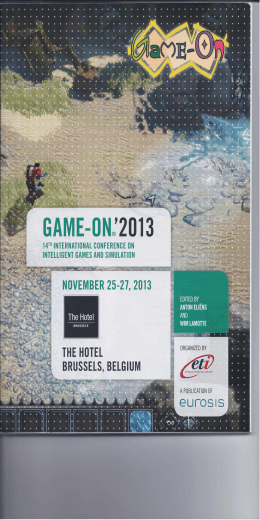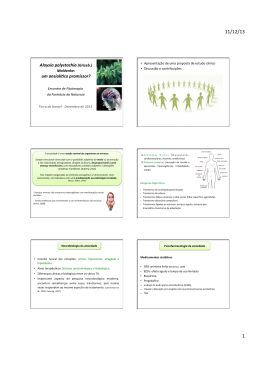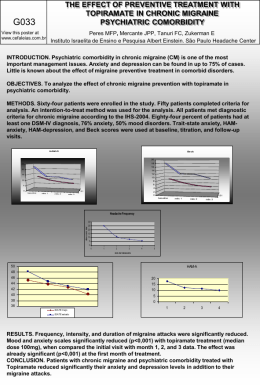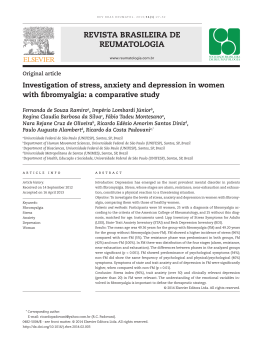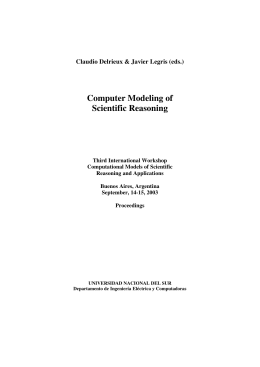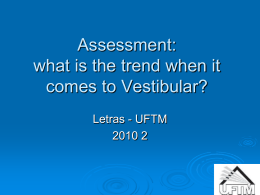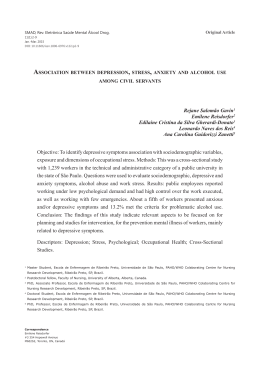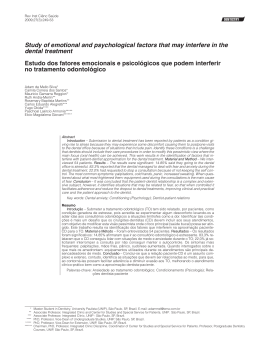Revista Interamericana de Psicología/Interamerican Journal of Psychology - 2009, Vol. 43, Num. 1 pp. 77-83 Arne Vikan1, 2 Norwegian University of Science and Technology, Trondheim, Norway Maria da Graça B. B. Dias Antonio Roazzi Federal University of Pernambuco, Recife, Brazil Abstract Students from a collectivistic (Brazilian, n= 401) and an individualistic (Norwegian, n= 418) culture rated their ability to display and conceal anger, sadness, and anxiety in relation to immediate family, partner, friends, and “other persons.” Norwegians showed higher display ratings for anger and sadness, and higher concealment ratings for anger and anxiety. Display ratings were much higher, and concealment ratings much lower in relation to close persons than in relation to “other persons.” A culture x relationship interaction was that Brazilians’ ratings suggested more emotional openness to friends than to family and partner, whereas Norwegians showed the inverse patterns. Gender differences supported previous research by showing higher display and lower concealment ratings, and less differentiation between relationships by females. Keywords: Emotion communication; displaying emotions; concealing emotions; collectivism. Avaliando a Comunicação da Emoção: O Ato de Mostrar e Ocultar como Efeitos da Cultura, Gênero, Tipo de Emoção e Relacionamento Resumo Estudantes de uma cultura coletivista (brasileiros, n= 401) e uma individualista (noruegueses, n= 418) pontuam suas habilidades em demonstrar e esconder raiva, tristeza e ansiedade em relação à família, companheiro, amigos e “outras pessoas”. Noruegueses mostram pontuações mais altas na manifestação da raiva e tristeza, e menores pontuações para encobrir raiva e ansiedade. As pontuações de expor foram muito mais altas, e o ocultar muito mais baixas em relação a pessoas mais íntimas do que em relação a “outras pessoas”. Uma interação entre cultura x relacionamento apresenta que os escores dos brasileiros sugerem maior abertura emocional para amigos do que para familiares e companheiros, enquanto os noruegueses denotam um o padrão inverso. Diferenças de gêneros apóiam pesquisas anteriores evidenciando que o sexo feminino tem escores mais elevado em expressar emoções e menores escores em esconder; também demonstram menos diferenciação entre os relacionamentos. Palavras-chave: Comunicando emoções; expressando emoções; escondendo emoções; coletivismo. Cultural variation in emotion is well known and has been discussed and described by a number of authors (e.g., Kitayama & Marcus, 1994; Mesquita & Frijda, 1992; Wierzbicka, 1986). Research has identified universals in emotional expression (Ekman & Friesen, 1971), whereas variation has been related to appraisal (Mesquita & Frijda, 1992), expression, and emotional experience (Scherer, Wallbott, & Summerfield, 1986; Wallbott & Scherer, 1986). There has, however, not been much cross-cultural research on the functional aspect of emotion. Communication is often noted as the key 1 Address: Norwegian University of Science and Technology, Department of Psychology, 7494, Trondheim, Norway. E-mail: [email protected] 2 Acknowledgement is due to Kyrre Svarva for help in preparing the statistical analyses. functional process in this respect, Buck (1984) noted for instance that emotion communication serves as the foundation of social order, and is thus a mirror of cultural diversity. The present study represents an approach in this context by a design to test the perception of two main communication skills in samples from two cultures. The emotions selected for the study were anger, anxiety and sadness. Measures were ratings on five point scales for the display and concealment of emotions, which have been noted, respectively, as “a basic form of emotional communication” (Planalp, 1999), and a “communicative phenomenon” (Buller & Burgoon, 1998). While display has mainly been acknowledged on the individual level and related to needs to talk about emotion (Rime, Corsine, & Herbette, 2002), and to psychological and physical health (e. g. Pennebaker, 1995), concealment R. Interam. Psicol. 43(1), 2009 77 ARTICULOS Rating Emotion Communication: Display and Concealment as Effects of Culture, Gender, Emotion Type, and Relationship ARNE VIKAN, MARIA DA GRAÇA B. B. DIAS, & ANTONIO ROAZZI ARTICULOS 78 of emotions has been identified as an important form of communication at the cultural level in terms of avoidance of negative emotions (e. g. Briggs, 1970; Wikan, 1990). There are no studies of the interrelationship between displaying and concealing emotions, but a reasonable assumption may be that persons or cultures which display much emotion show little concealment, and that the skills consequently are negatively correlated. The assumption that persons who know how to display emotions are also adept at concealment them may on the other hand suggest a positive correlation, and be equally reasonable. The research literature offers little help in clarifying this issue. Emotion communication has been discussed in a handful of books in recent years (Andersen & Guerrero, 1998; Barrett, 1997; Fussell, 2002; Planalp, 1999), but this has not involved research on emotional communication skills. The literature provides some clues as to effects of emotion type on emotion communication. Planalp (1999) noted, for instance, that anger is considered a “talkative”, and fear and sadness “silent” emotions. This is similar to interpretations of anger as an externalizing, and anxiety and sadness as internalized emotions (Achenbach, 1991; Bradley, 2000), which can mean that anger is more easily displayed, and anxiety and sadness better concealed in emotional communication. Cultural variation relating to emotion communication can, furthermore, be associated with the distinction between individualistic and collectivistic social orientations (Triandis, 1995, 2001). Mesquita (2001) held for instance that core characteristics of these orientations, such as individualists’ relative independence and collectivists’ relative interdependence on their reference groups, were reflected in cultural variation in the meaning of emotional events. The present study comprised samples from Brazil and Norway, which have been shown as, respectively, collectivistic and individualistic cultures in comparisons which have included student samples similar to the present ones (Biaggio, Vikan, & Camino, 2005; Hofstede, 1991), as well as in single culture studies (Gooch, 1995; Gouveia, Albuquerque, Clemente, & Espinosa, 2002). Comparisons have suggested that individualists show higher expressiveness and endorsement of anger, and a tendency to communicate a wider variety of emotions (Earley & Gibson, 1998; Matsumoto, 1991), while collectivists produce more positive and suppress more negative emotions (Hammer & Gudykunst, 1986; Porter & Samovar, 1998). This led to expectations that Brazilians would show lower scores on ratings of display and higher scores on ratings of concealment than Norwegians for all three emotions in the present study. Gender is a relevant source of variation for the present design, as indicated by females higher emotional expressiveness, and confidence related to emotion expression except for anger (Wood, 1997), and by greater willingness to discuss emotions (Fischer, 1993). Corresponding expectations were that females should score higher on display, and lower on concealment than males for anxiety and sadness. An additional source of variation was suggested by Planalp’s (1999) discussion of risks involved in communicating emotions to others, such as violating norms about self-disclosure and showing personal weakness. While this can suggest why some emotions are more difficult to communicate than others, it also points to relationship as a variable. This was included in the present study by having students rate their skills in displaying and concealing emotions in relation to spouse/partner, immediate family, friends, and “other persons.” Both experience and types of relationship are likely sources of variation in emotional communication. Straightforward expectations were that display is easier and should be rated as higher, and concealment more difficult and should be rated as lower in relationships where a person has a long relationship history, such as in students’ relationship with immediate family, as compared to relationships with less experience, such as in their relationships with friends and spouse/partner. Expectations were also that display should be rated as lower, and concealment as higher in relation to “other persons” as compared to immediate family, friends, and spouse/partner. Method Participants Participants were 819 students (408 females and 411 males), 418 (208 females and 210 males) from Norway and 401 (201 females and 200 males) from Brazil. 98.8 % of females were psychology students, whereas 62.4 % of the males were studying engineering or biology, and 37.7% were in an officers’ training academy. Students in both countries were into the second, third or fourth term, whereas engineering students and officer cadets were into their third year of study. Age was recorded in terms of categories, and frequency distributions were similar by showing Brazilian and Norwegian percentages of, respectively, 17.5 and 17.0 younger than 20 years, 61.3 and 62.8 in the 20-24 year, and 14.7 and 14.1 in the 25-29 year age range. Design The design of the study conforms to a 2 (culture) x 2 (gender) x 3 (emotion type anger, sadness, and anxiety) x 4 (relationships as spouse/partner, closest family, friends, and others) mixed factorial with repeated measures for the last two factors. R. Interam. Psicol. 43(1), 2009 RATING EMOTION COMMUNICATION: DISPLAY AND CONCEALMENT AS EFFECTS OF CULTURE, GENDER, EMOTION... Procedure The questionnaires were completed in about 30 minutes during the students’ ordinary lectures. Participation was anonymous and voluntary. Scoring Scoring of responses where straightforward by assigning points from 1-5 for scale ratings. Scores from the four disclosure items and the four concealment items (one for each context) were added to form, respectively, a disclosure and a concealment index for each emotion, resulting in six communication skills x emotion indexes. High index scores indicated high belief in the ability to display and to conceal an emotion. Analyses Structural equivalence analyses of scores from the culture samples were made by confirmatory factor analyses of the Brazilian indexes based on results from exploratory prinicipal component analyses with direct obliging rotation on the index scores in the Norwegian sample. Analyses of each emotion communication skill were made by repeated measures ANOVAs with age as covariate, and Bonferroni adjusted comparisons of factor levels. Results Mean alphas for display and concealment indices were, respectively, .78 (range .66-.86) and .79 (range .71-.88) for the whole sample, .77 (range .66-.86) and .79 (range .71-.88) for the Brazilians, and .82 for both indices (range .75-.84, and .74-.87, respectively) for the Norwegians. All distributions were approximately normal. Structural Equivalence Exploratory factor analyses of index scores from the Norwegian sample showed mean Eigenvalue and percentage explained variance of, respectively, 2.62 (range 2.41 to 2.91) and 65.5 % (range 60.3 % to 72.6 %), and one component in each index. The results of SEM analyses of the Brazilian scores indicated a satisfactory equivalence for concealment responses with goodness of fit indexes (GFI) and root mean square error of approximations (RMSEA) of, respectively, .99 and .067, .99 and .090, and .995 and .054 for anger, anxiety and sadness. Equivalence showed larger variations with emotion type for the display indexes, where GFI and RMSEA were 1.00 and .100 for anger, 0.96 and 0.153 for anxiety, and 0.97 and 0.118 for sadness. Displaying Emotions To have an overview, Table 1 shows display ratings by emotion type, culture, and gender, whereas ratings pertaining to relationships are shown in Table 2. The higher ratings for Norwegians and females shown in Table 1 were corroborated by main effects of [F(1, 783)= 15.66], for culture, and [F(1, 783)= 15.78] for gender, both p < .01. The analyses showed an emotion Table 1 Mean and SD for Display Index Ratings by Emotion Type, Culture, and Gender Valid n Anger Mean Emotions Anxiety SD Mean SD Sadness Mean SD Total Mean Norwegians Brazilians 394 377 14.8 13.6 3.1 3.3 14.1 13.7 3.4 3.5 14.5 13.7 3.1 3.3 14.5 13.7 Females Males 377 394 14.5 13.9 2.9 3.6 14.3 13.4 3.0 3.8 14.5 13.7 2.9 3.5 14.4 13.7 Total sample 771 14.2 3.3 13.9 3.5 14.1 3.2 14.1 Sample R. Interam. Psicol. 43(1), 2009 79 ARTICULOS Measures Responses were ratings on five point scales in selfreport questionnaires. Instructions and items were translated from Norwegian to Portuguese in a forwardback procedure. Scale points were: “Not at all”, “only a little”, “in part”, “mostly”, and “totally.” Instruction for display ratings was: “If you are (angry, anxious, sad) and want that others shall understand how you feel, can you make yourself understood to...” Instruction for conceal ratings was: “When you are (angry, anxious, sad), are you able to conceal the emotion for…” Rating targets were spouse/partner, persons in the immediate family, closest friends, and “other persons.” Ratings were made for each of three emotions, and each participant therefore responded with 24 ratings. ARNE VIKAN, MARIA DA GRAÇA B. B. DIAS, & ANTONIO ROAZZI ARTICULOS 80 x culture interaction effect, [F (2, 1566) = 7.51, p < .01], which pertained to higher Norwegian ratings for anger and sadness than anxiety of, respectively, [F(1, 804)= 31.79] and [F(1, 804)= 11.47], both p < .01, in one-way ANOVAs. Table 2 shows the distribution of display ratings by relationships, culture, and gender, where ratings for “others” are clearly lower than for personal relationships. This was supported by a main effect for relationships [F= 107.39 (3, 2349), p < .01], the results furthermore showed relationship x culture, and relationship x gender interaction effects of, respectively, [F(3, 2349)= 87.13], and [F(3, 2349)= 5.49]. The main effect pertained to differences corresponding to p< .01 between all relationships; the smallest difference was between spouse/partner and friends. The relationship x culture interaction effect was that Brazilians’ display ratings were highest for friends, and lowest to spouse/partner with family in-between, while Norwegians’ display showed the inverse pattern. Separate ANOVAs for cultures showed p < .01 for comparisons of all relationships except for Brazilians’ ratings of display to spouse/partner and family. Separate ANOVAS for gender indicated that the relationship x gender pertained to less differentiation in females’ ratings, as shown by a non significant comparison of spouse/partner and friends, and a significant comparison of p = .03 for spouse/partner and friends, as compared to p < .001 for all relationship differences in males’ ratings. Concealing Emotions The ratings for concealing emotions are also first shown by emotion type, culture, and gender in Table 3. The ANOVA on ratings for concealment showed main effects for country, F(1, 783)= 15.58, gender, F(1, 783)= 68.26, and emotion, F(2, 1566)= 116.59, all p < .01. Table 3 suggests that the country and gender effects pertained to, respectively, higher ratings of concealment for Norwegians and males, while the adjusted comparisons showed that the emotion effect related to higher ratings for anxiety than for anger and sadness. Interaction effects were shown for emotion x culture, F(2, 1566)= 4.98, p < .01, and emotion x gender, F(2, 1566)= 3.36, p = .035. As is indicated in Table 3, this relates to higher Norwegian ratings for anger and anxiety, which were supported by one-way ANOVA differences of, respectively, F(1, 806)= 27.30, and F(1, 797)= 7.35, both p < .01, and no difference in rating of sadness. The emotion x gender interaction related to a larger difference between females and males for anxiety than for anger and sadness. Table 2 Mean and SD for Display Index Ratings by Relationships, Culture, and Gender Spouse/partner Immediate family Closest friends Others Culture Brazil Norway (n=377) (n=394) Mean SD Mean SD Gender Females Males (n=377) (n=394) Mean SD Mean SD Total Sample (n=771) Mean SD 10.7 10.9 11.3 7.8 12.0 11.3 11.5 8.3 11.8 11.2 11.2 8.0 2.7 2.6 2.3 2.7 2.8 2.7 2.3 2.6 12.9 11.4 11.0 8.2 2.0 2.6 2.4 2.8 2.5 2.5 2.1 2.6 11.6 11.0 10.8 7.8 2.8 2.8 2.5 2.8 Table 3 Mean and SD for Concealment Index Ratings by Emotion Type, Culture, and Gender Sample Valid n Anger Mean SD Emotions Anxiety Mean SD Sadness Mean SD Total Mean Norwegians Brazilians 394 377 12.2 10.9 3.3 3.5 14.0 13.2 4.4 4.0 12.0 11.7 3.5 3.6 12.7 11.9 Females Males 377 394 10.9 12.2 3.4 3.4 12.6 14.6 3.8 4.0 11.1 12.7 3.2 3.6 11.5 13.2 Total sample 771 11.6 3.5 13.6 4.0 11.9 3.5 12.4 R. Interam. Psicol. 43(1), 2009 RATING EMOTION COMMUNICATION: DISPLAY AND CONCEALMENT AS EFFECTS OF CULTURE, GENDER, EMOTION... 81 Spouse/partner Immediate family Closest friends Others Culture Brazil (n=377) Mean SD Norway (n=394) Mean SD Gender Females Males (n=377) (n=394) Mean SD Mean SD Total Sample (n=771) Mean SD 8.8 8.3 7.8 10.9 7.3 8.8 9.9 12.1 7.3 7.8 8.1 11.3 8.0 8.5 8.9 11.5 2.6 2.6 2.7 2.6 3.0 2.8 2.6 2.2 Table 4 shows the distribution of concealment ratings by relationships, culture, and gender. The ANOVA showed a main effect of relationships, [F=(3, 2343) =77.25, p < .01], with adjusted comparisons of p < .01 in all instances. A relationships x culture effect of [F(3, 2343)=144.96, p < .01], and variations shown in Table 4 suggest the same pattern of differences as was shown for display ratings. Brazilians showed lower ratings for friends than for spouse/partner, with family in between, and Norwegians showed an inverse pattern. Differences in ratings were corroborated by adjusted comparisons tests. The ANOVA also showed relationship x gender, [F(3, 2349)=18.54], relationship x emotion, [F(6, 4686) =3.24], and relationship x age interaction effects, [F(3, 2343)=4.19], all p < .01. The relationship x gender effect showed, as for display, lower differentiation in females’ ratings of relationships as indicated by a mean difference of .11, p = .047, and in their ratings of family and friends, as compared to the p < .001 significance of all of male’s ratings. The relationships x emotion effect referred to highest ratings for anxiety in all relationships, and with higher ratings for sadness than anger in the family and “other persons” relationships, which showed Wilcoxon z of, respectively, 3.37 (p < .01), and 12.19 (p = .03). The relationship x age interaction effect pertained to higher concealment ratings for anxiety and sadness in the 25-29 age group, as compared to the 20-24 age group. Correlational Analysis Intercorrelations between display ratings were .49, .55, and .63, respectively for anger and anxiety, anger and sadness, and anxiety and sadness. Corresponding correlations for the concealment ratings were lower, and were .33, .48, and .44. Separate analyses for country showed somewhat higher correlations for Norwegians than for Brazilians. Correlations between display and concealment indices were all negative, and were -.05 for anger (not significant), -.16 for anxiety and -.20 for sadness (both p < .01). R. Interam. Psicol. 43(1), 2009 2.8 2.6 2.7 2.4 8.8 9.2 9.7 11.7 2.8 2.6 2.7 2.6 2.7 2.9 2.8 2.8 Discussion The lower expressiveness (Earley & Gibson, 1998), greater suppression (Porter & Samovar, 1998) and lower disclosure (Hammer & Gudykunst, 1986) of negative emotions in collectivistic cultures were supported by the expected lower display ratings of negative emotions, except for anxiety, by the collectivistic Brazilians. Ratings for concealing emotions showed non-expected higher scores from the individualistic Norwegians on anger and anxiety. The results supported expectations based on previous research on gender differences (Fischer, 1993; Wood, 1997) by showing higher display ratings for females, though without the expected exception for anger, and higher concealment ratings for males. The lower differentiation shown by females in ratings of display and concealment to close persons is consistent with females’ greater focus on relationships (Wood, 1997). It must be noted that the gender difference may have been elevated due to a selection of participants from traditional gender role studies. A main problem for the interpretation of results was the somewhat unsatisfactory SEM indications of equivalence for display ratings of anxiety and sadness in the two cultures. This can mean that responses showed culture biases, for instance in the meaning of the term “display,” and/or in participants’ interpretation of emotion terms. There seems to be a distinct tendency of judging a bias of some type as a disqualification of results (Byrne & Watkins, 2003; Van de Vijver, 2003), which is associated to a not unproblematic notion of a “pure” cultural difference. The key point in the present context is that the results of display ratings of anxiety and sadness were parallel to the ratings for anger, and showed, like the ratings of anger, complementary ratings to ratings of concealment. Thus, the bias suggested by the SEM analyses may not be a difference which makes a difference. It may on the other hand make a difference to include positive emotions such as happiness and interest. This was not possible because the questionnaires were already ARTICULOS Table 4 Mean and SD for Concealment Index Ratings by Culture, Gender, and Relationship ARNE VIKAN, MARIA DA GRAÇA B. B. DIAS, & ANTONIO ROAZZI ARTICULOS 82 very voluminous, but the exclusion of positive emotions represents a decisive limitation on interpretations of culture differences. Differences in response style in terms of acquiescence and extremity ratings have been noted in questionnaire studies of collectivistic and individualistic samples (Herk, Poortinga, & Verhallen, 2004), and might also be considered a problem in the present study. Acquiescence did however not appear as a relevant rating in the present response format, and extreme response style was examined by Bachman and O’Malley’s (1984) procedure, and did not show a culture bias. It was surprising in relation to the dominant theory that emotions are discrete, adaptive structures (Ackerman, Abe, & Izard, 1998; Izard, 1991) that the results showed only the main effect of emotion type that concealing anxiety was rated higher, i. e. as more easily concealed, than anger and sadness. This was in contrast to Scherer et al. (1986) results that anger obtained the highest score for hiding an emotion. Anxiety should be difficult to conceal because of easily observable expressive cues such as flushing, shaking, and uneasiness, but concealment may seem “easy” because anxiety is often concealed by avoidance, which is a predominant response to this emotion. The results supported expectations that display and concealment with respect to “other persons” should be, respectively, lower and higher than for well-known persons. The relationship difference in this respect may correspond to the distinction between out-group and in-group persons. This difference has been held as much greater in collectivistic than in individualistic cultures (Gudykunst & Matsumoto, 1996). This was not supported by the present results, which showed “relationship” as a key source of variation of emotional communication in both culture types. Relationships was mentioned as variable in emotion expression in Scherer et al. (1986) pioneering study, but no previous research could lead one to expect that this, in terms of the size of main effects and the number of interaction effects, was probably the dominant source of variation in ratings of emotion communication in the present study. A salient result was the complementary relationship x culture interactions, where display ratings were higher and concealment ratings lower for spouse/ partner than for friends, with family in-between for Norwegians, as compared to the inverse relation of these three relationships on both measures for Brazilians. An expectation of higher display and lower concealment for closest family was thus not supported. It should be noted that “spouse/partner” was a somewhat unfortunate category as it is ambiguous and may refer both to spouse, partner, and friends. It is reasonable to interpret the reference as spouse or partner for the great majority of young persons (students) who participated in this study. The results, therefore, can be interpreted as suggesting that the most intimate person for the Norwegians was spouse/partner, whereas Brazilians’ most intimate person appeared to be friends. This can be supported by research which indicates that the relationship to spouse/partner is more intimate in individualistic than in collectivistic cultures (Dion & Dion, 1993), and by the observation that friendships is important in Brazilian culture because most problems outside the home must be solved through personal acquaintances (Rector & Neiva, 1996). It might also be that friendships in collectivistic cultures can provide a “safety valve” for the display of one’s intimate thoughts and feelings. A contrasting observation to the present reasoning is provided by Hecht and Ribeau’s (1984, see Burleson, 2003) observation that persons in individualistic cultures prefer greater emotional intimacy with friends than do persons in collectivistic cultures. The correlations between display and concealment ratings were negative, low, and showed variation with emotion type and relationship. Except for Norwegians correlations for anger, the correlations were similar for ratings of both cultures’ close relationships and can suggest that emotion communication in these instances showed a relatively high degree of display and a low degree of concealment, whereas emotion communication to outsiders are characterized by little display and much concealment. The low correlations furthermore indicate that display and concealment are independent skills which show much individual variation. A suggestion may be that the combination of display-concealment skills for specific emotions may characterize individual emotional communication, such as for instance the high-low anxiety, and low-high anger display often shown in patients with anxiety disorder, and the high-low contentment and low-high both sadness and anger emotion communication which is evident in Balinese culture (Wikan, 1990). References Achenbach, T. M. (1991). Integrative guide for the 1991 CBCL/4-18, YSR, and TRF profiles. Burlington, VT: University of Vermont. Ackerman, B. P., Abe, J. A. A., & Izard, C. E. (1998). Differential emotions theory and emotional development. In M. F. Mascolo & S. Griffin (Eds.), What develops in emotional development? (pp. 85106). New York: Plenum Press. Andersen, P. A., & Guerrero, L. K. (Eds.). (1998). Handbook of communication and emotion. San Diego, CA: Academic Press. Bachman, J. G., & O’Malley, P. M. (1984). Yea-saying, nay-saying, and going to extremes: Black-white differences in response styles. Public Opinion Quarterly, 48, 491-509. Barrett, K. C. (Ed.). (1997). The communication of emotion: Current research from diverse perspectives. San Francisco: Jossey-Bass. Biaggio, A., Vikan, A., & Camino, C. (2005). Orientação social, papel sexual e julgamento moral: Uma comparação de duas amostras brasileiras e uma norueguesa. Psicologia: Reflexão e Crítica, 18, 1-6. R. Interam. Psicol. 43(1), 2009 RATING EMOTION COMMUNICATION: DISPLAY AND CONCEALMENT AS EFFECTS OF CULTURE, GENDER, EMOTION... Izard, C. E. (1991). The psychology of emotions. New York: Plenum Press. Kitayama, S., & Markus, H. R. (Eds.). (1994). Emotions and culture: Empirical studies of mutual influence. Washington, DC: American Psychological Association. Matsumoto, D. (1991). Cultural influences on facial expressions of emotion. The Southern Communication Journal, 56, 128-137. Mesquita, B. (2001). Emotion in collectivist and individualist cultures. Journal of Personality and Social Psychology, 80, 68-74. Mesquita, B., & Frijda, N. H. (1992). Cultural variations in emotions: A review. Psychological Bulletin, 112, 179-204. Pennebaker, J. W. (Ed.). (1995). Emotion, disclosure, and health. Washington, DC: American Psychological Association. Planalp, S. (1999). Communicating emotion. Cambridge, MA: Cambridge University Press. Porter, R. E., & Samovar, L. A. (1998). Cultural influences on emotional expression: Implications for intercultural communication. In P. A. Andersen & L. K. Guerrero (Eds.), Handbook of communication and emotion (pp. 451-472). San Diego, CA: Academic Press. Rector, M., & Neiva, E. (1996). Communication and personal relations in Brazil. In W. B. Gudykunst, S. Ting-Toomey, & T. Nishida (Eds.). Communication in personal relationships across cultures (pp. 156173). London: Sage. Rime, B., Corsini, S., & Herbette, G. (2002). Emotion, verbal expression, and the social sharing of emotion. In S. R. Fussell (Ed.), The verbal communication of emotions (pp. 185-208). Mahwah, NJ: Lawrence Erlbaum. Scherer, K. R., Wallbott, H. G., & Summerfield, A. B. (Eds.). (1986). Experiencing emotion. Cambridge, MA: Cambridge University Press. Triandis, H. C. (1995). Individualism and collectivism. Boulder, CO: Westview Press. Triandis, H. C. (2001). Individualism-collectivism and personality. Journal of Personality, 69, 907-924. Van de Vijver, F. J. R. (2003). Bias and equivalence: Cross-cultural perspectives. In J. A. Harkness, F. J. R. Van de Vijver, & P. Mohler (Eds.), Cross-cultural survey methods (pp. 143-155). New York: Wiley. Wallbott, H. G., & Scherer, K. R. (1986). How universal and specific is emotional experience? Evidence from 27 countries on five continents. Social Science Information, 25, 763-795. Wierzbicka, A. (1986). Human emotions: Universal or culture specific? American Anthropologist, 88, 584-594. Wikan, U. (1990). Managing turbulent hearts: A Balinese formula for living. Chicago: University of Chicago Press. Wood, J. T. (1997). Gendered lives: Communication, gender, and culture (2nd ed.). Belmont, CA: Wadsworth. Received 22/02/2008 Accepted 18/08/2008 Arne Vikan. Norwegian University of Science and Technology, Department of Psychology, Trondheim, Norway. Maria da Graça B. B. Dias. Federal University of Pernambuco, Graduate Program in Psychology, Recife, Brazil. Antonio Roazzi. Federal University of Pernambuco, Graduate Program in Psychology, Recife, Brazil. R. Interam. Psicol. 43(1), 2009 83 ARTICULOS Bradley, S. J. (2000). Affect regulation and the development of psychopathology. New York: The Guilford Press. Briggs, J. (1970). Never in anger: Portrait of an Eskimo family. Cambridge, MA: Harvard University Press. Buck, R. (1984). The communication of emotion. New York: The Guilford Press. Buller, D. B., & Burgoon, J. K. (1998). Emotional expression in the deception process. In P. A. Andersen & L. K.Guerrero (Eds.), Handbook of communication and emotion (pp. 381-402). San Diego, CA: Academic Press. Burleson, B. R. (2003). The experience and effect of emotional support: What the study of gender differences can tell us about close relationships, emotion, and interpersonal communication. Personal Relationships, 10, 1-23. Byrne, B. M., & Watkins, D. (2003). The issue of measurement invariance revisited. Journal of Cross-Cultural Psychology, 34, 155-175. Dion, K. K., & Dion, K. L. (1993). Individualistic and collectivistic perspectives on gender and the cultural context of love and intimacy. Journal of Social Issues, 49, 53-59. Earley, P. C., & Gibson, C. B. (1998). Taking stock in our progress on collectivism-individualism: 100 years of solidarity and community. Journal of Management, 24, 224-265. Ekman, P., & Friesen, W. V. (1971). Constants across cultures in the face of emotion. Journal of Personality and Social Psychology, 17, 124129. Fischer, A. H. (1993). Sex differences in emotionality: Fact or stereotype? Feminism & Psychology, 3, 303-318. Fussell, S. R. (Ed.). (2002). The verbal communication of emotions. Mahwah, NJ: Lawrence Erlbaum. Gooch, G. D. (1995). Environmental beliefs and attitudes in Sweden and the Baltic states. Environment and Behavior, 27, 513-539. Gouveia, V. V., Albuquerque, F. J. B., Clemente, M., & Espinosa, P. (2002). Human values and social identities: A study in two collectivist cultures. International Journal of Psychology, 37, 333-342. Gudykunst, W. B., & Matsumoto, Y. (1996). Cross-cultural variability of communication in personal relationships. In W. B. Gudykunst, S. Ting-Toomey, & T. Nishida (Eds.), Communication in personal relationships across cultures (pp. 19-56). London: Sage. Hammer, M. R., & Gudykunst, W. B. (1986). The influence of ethnicity and sex on social penetration in close friendships. Journal of Black Studies, 17, 418-437. Hecht, M. L., & Ribeau, S. A. (1984). Ethnic communication: A comparative analysis of satisfying communication. International Journal of Intercultural Relations, 8, 135-151. Herk, H., Poortinga, Y. H., & Verhallen, T. M. M. (2004). Response styles in rating scales: Evidence of method bias in data from six EU countries. Journal of Cross-Cultural Psychology, 35, 346-360. Hofstede, G. (1991). Cultures and organizations: Software of the minds. London: McGraw Hill.
Download
